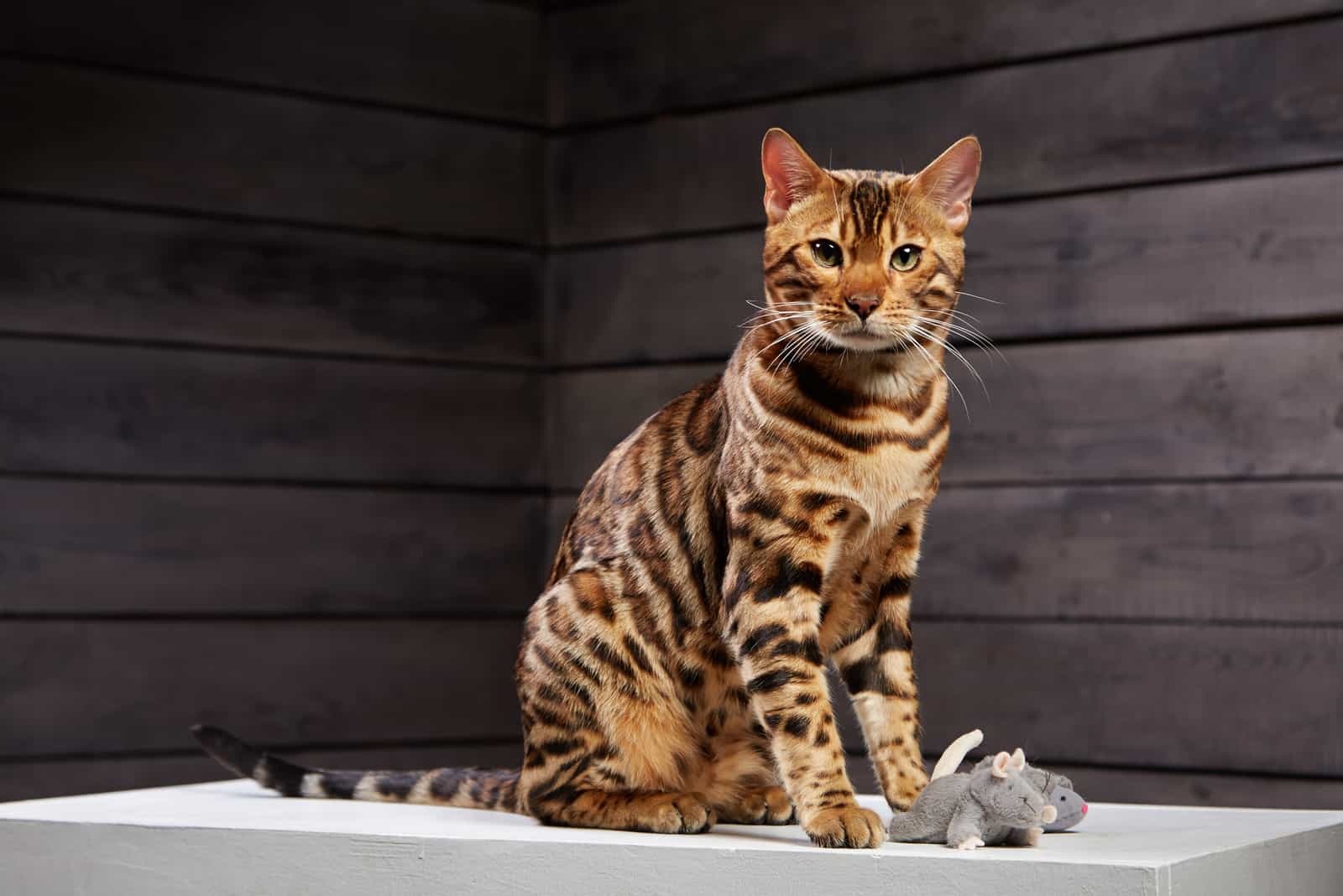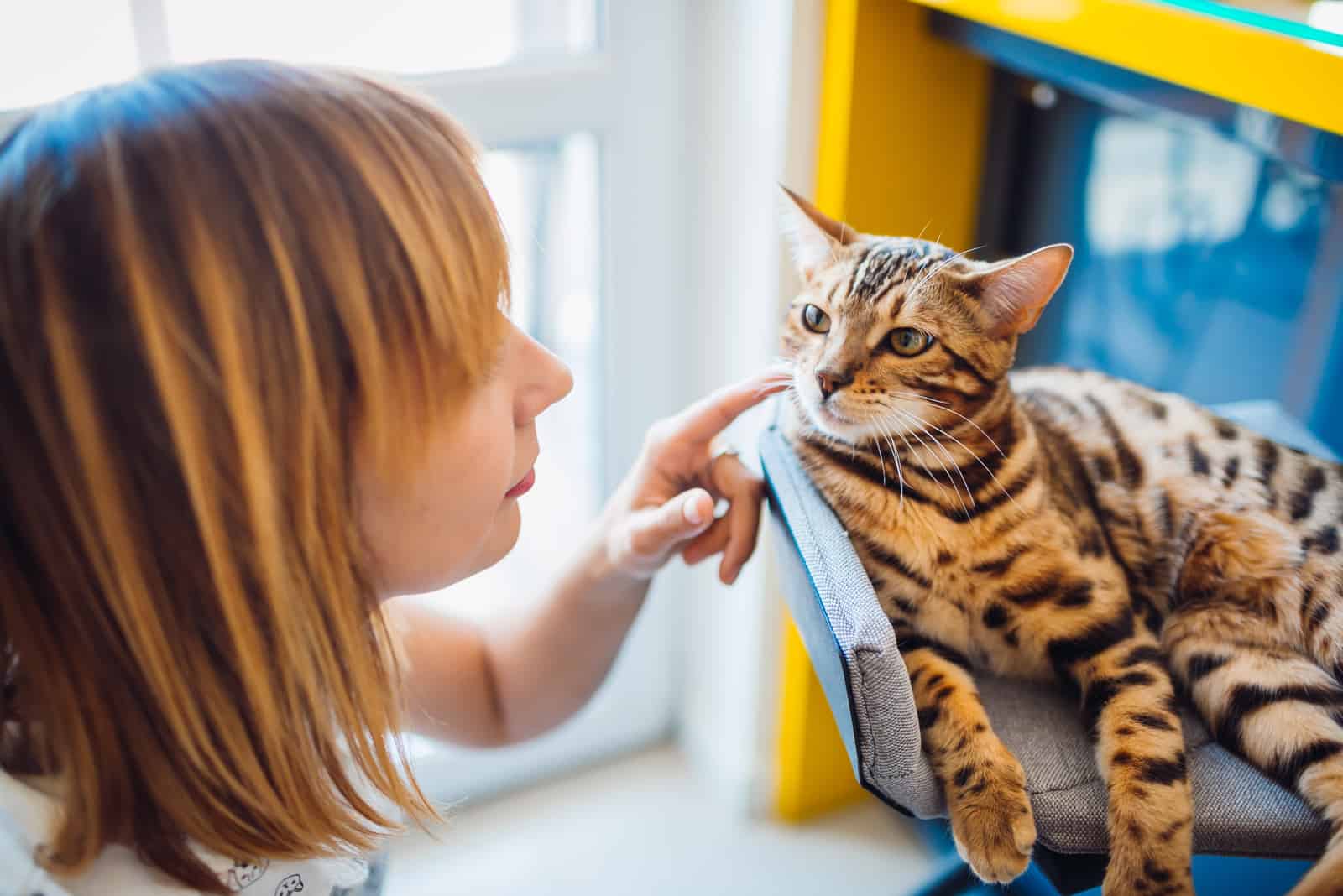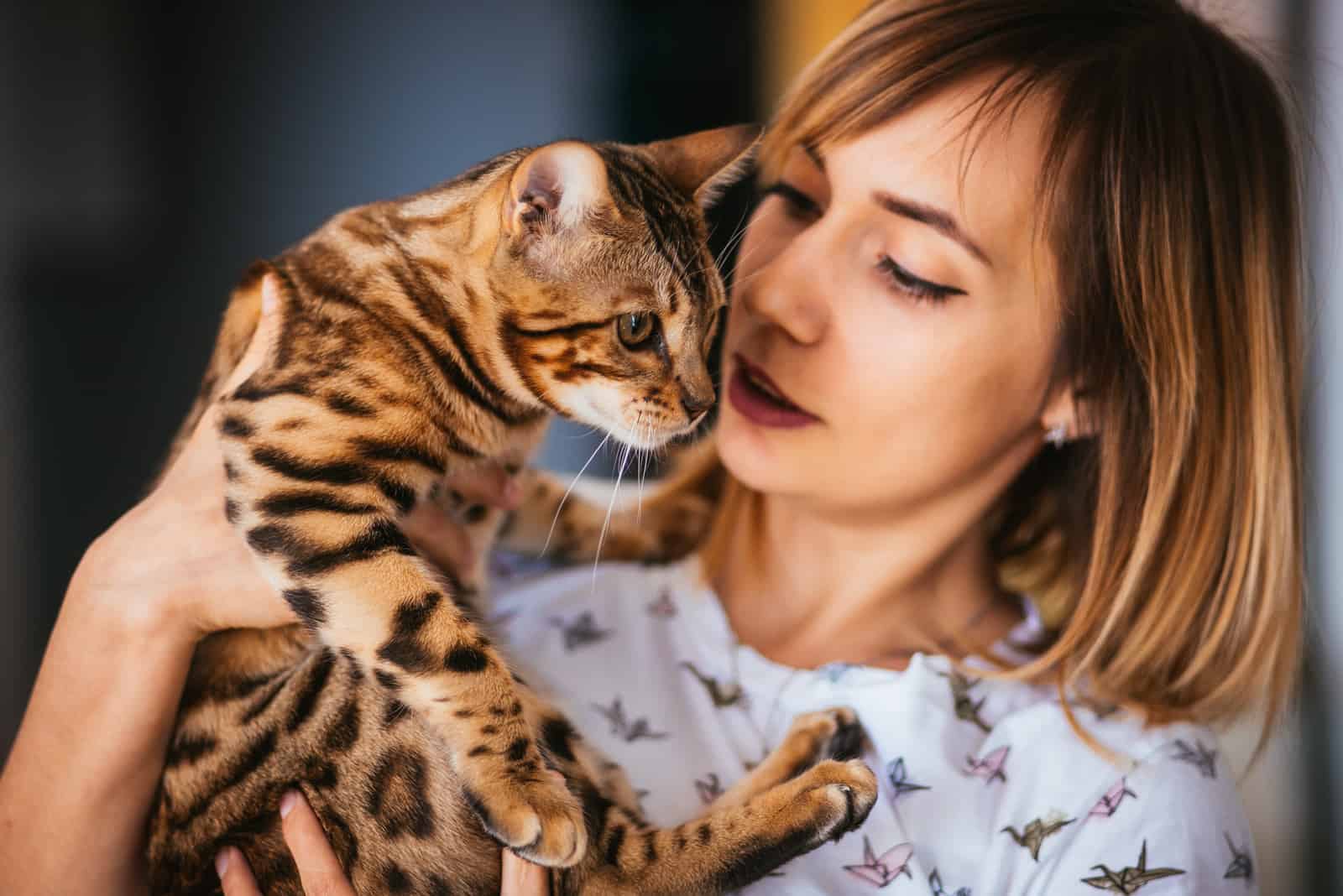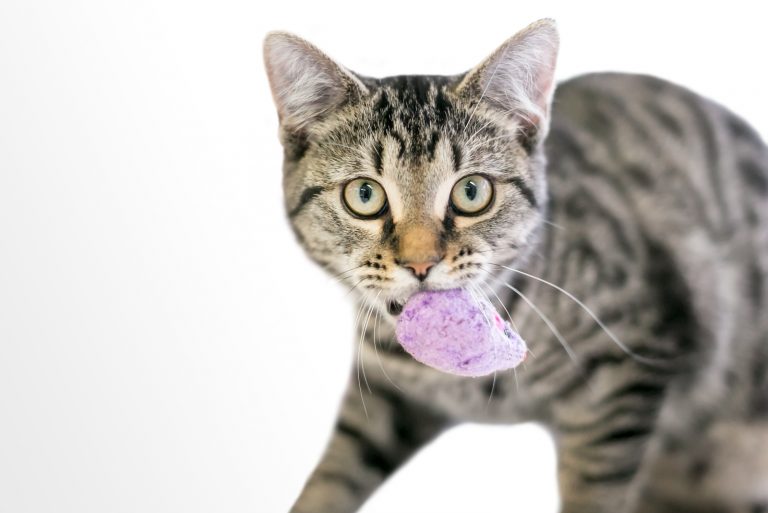How To Discipline A Bengal Cat – 8 Steps

Is your Bengal cat misbehaving? Do you often return to your studio apartment expecting to find your sofa ruined? Or maybe your Bengal cat is adamant in climbing onto the countertops?
Do not despair, because we are going to teach you how to discipline a Bengal cat!
Smart, persistent, and regal-looking, Bengal cats can be amazing companions, but their behavior problems can sometimes drive even the most patient cat owners insane.
This is nothing surprising, considering that this cat breed came into existence only about fifty years ago, when the Shorthair domestic cat was crossed with the wild Asian leopard.
Due to their high energy levels, Bengal cats can often seem “needy”. If you don’t have the time to properly discipline your cat, we suggest you rethink being a Bengal cat owner.
Stick around to discover some common causes of negative Bengal cat behavior, and the DOs and DON’Ts of remedying that bad behavior.
How To Discipline A Bengal Cat
Bengal cats are still partly wild cats which means they will always act on instinct. This means that you will have to rewire their circuits.
Scratching, climbing, littering, getting in fights with other house cats, and many other elements of what we consider “bad behaviors” are just how a normal cat naturally acts.
It is important not to get mad when your cats act a certain way, because they don’t do it intentionally.
The most important tools you’ll need for disciplining your Bengal kitten are time and patience.
If you cannot relate your housecat’s behavior to anything in this article, we suggest you take your Bengal to a vet. Make sure your cat is not experiencing any health problems which might influence its behavior.
Here’s everything you need to know on how to discipline a Bengal cat:
1. Never Use Aggressive Punishment

We find it incredibly important to start with this: “Never act aggressively toward your Bengal cat”.
Bengal cats are very sensitive to sounds, and we strongly discourage you from trying to discipline your cat in a loud manner such as shouting.
If you want to use their strong hearing to your advantage, try to incorporate clickers in your training.
Clickers will help your Bengal cat to tie specific clicking sounds to certain commands, and this will make your job much easier.
Also, you must always restrain yourself from physical punishment. If you want to discipline your cat, hitting it, pulling its tail, throwing it (etc.) will only make your cat hate you and is a form of animal abuse which is a serious offense.
For example, if your indoor cat is constantly scratching at your sofa, screaming and hitting it will not help. Your Bengal cat might stop that negative behavior while you’re near, but they will engage in it as soon as you’re out of sight.
All in all, if you try to discipline your cat through punishment and negative stimuli, you can be sure that nothing good can come of it.
2. Correct Bad Behavior On Time
Your Bengal house cat does not understand that it’s doing something wrong. This is a semi-wild cat that acts strictly on instinct.
Therefore, if a cat is doing something you consider misbehaving, it is important to correct the “bad behavior” while it is happening.
If you try to discipline your cat after it has already done something, you will only confuse it, and this will make discipline much harder.
If you discipline your cat after it has done something wrong, it will not understand the motive. All it sees is a tall creature threatening it when it’s doing absolutely nothing.
Disciplining after the fact will only make you seem cruel to your Bengal cat.
3. Never Reward Bad Behavior

As you probably already understand, it is important to teach your cat right from wrong.
They will not learn by themselves, and awarding misbehaving is one of the worst things to do.
Your Bengal cat will connect the bad behavior with positive reinforcement, and you will never see the end of it.
Quick example, imagine your Bengal cat trying to pry open a cupboard to find a tasty snack in there.
You hear the meowing, the struggling to open the cupboard, and instead of waiting for your house cat to stop with the shenanigans, you get annoyed and give it the snack from the cupboard.
You have successfully taught your Bengal cat that it can get a snack by meowing at the cupboard.
4. Buy/Make A Scratching Post
If you don’t want your Bengal cat to scratch, do not get a Bengal cat (or any other breed of cat)!
Scratching for cats is a natural instinctive thing. Cats scratch to stretch, maintain their claws, mark their territory, etc. They can also use scratching to express anxiety, excitement and other feelings.
Cats scratching is not a problem, scratching furniture is a problem.
This brings us to the concept of Yes/No dynamic, which means that you need to make the unwanted behavior unpleasant for your Bengal Cat.
If you want to discipline your cat when it comes to scratching, make sure that you have some other object that the cat can scratch.
We recommend buying a tall scratching pole, which should naturally attract your housecat anyway.
During the furniture scratching, make sure that you use a firm command “NO”, all while gently relocating your Bengal cat to the appropriate scratching object.
Placing the scratching post near your housecat’s sleeping location is recommended, since cats like to stretch by scratching upon waking.
5. Make Countertops Unappealing
Every discussion on how to discipline a Bengal cat always comes around to the protection of countertops.
Not many things are more natural for a cat than climbing to high positions. Natural predators, especially felines, often enjoy the benefit of a vantage point, and your Bengal cat is no different.
Additionally, proximity to water, and the scent of food, make the countertops a prime location for your Bengal cat. However, there is an easy way to discipline your Bengal cat from climbing your kitchen surfaces.
This process can also be completed through the YES/NO dynamic. You need to provide a negative sensation for the countertop, while providing some other place for climbing.
The easiest thing to do is to cover your countertop with sticky tape. Cats hate anything sticky, and this will discourage your Bengal cat from climbing onto your countertops.
Also try to incorporate the scent of citrus fruit such as lemon to your countertop. Cats are repelled by citrus fruits, and this will help discipline your cat to stay away from kitchen surfaces.
Now, when you make sure that your cat will stay away from the countertops, make sure that you give some positive reinforcement in the other direction.
This should include bringing some other tall object into the living room.
Cats love high ground, which is why you have to make sure they have something to climb. The best thing for this is to get a cat tree.
6. Understand Their Littering Process

If you have ever had a cat, you know how stinky cat litter can be. From pooping to urinating in undesignated places, having cat litter all over your house is a nightmare.
Consult your vet to make sure that there are no health problems which may be influencing your housecat’s littering.
Once you make sure that your cat is healthy, you should discipline your cat to litter in appropriate places.
If the Bengal cat is new to your home, make sure that it knows where the litter box is.
When they learn the layout of their living quarters, you can try to move the litter box to some other room, to combat the stench intensity.
If you live in a multistory home, you should get a litterbox for every story.
If your Bengal cat continues to urinate outside the litterbox, try to get a different model. The type of the litter box can sometimes affect your housecat’s willingness to use it.
You might also want to reconsider the location of the litter box. Sometimes, Bengal cats can dislike the location of the litter box, so try to move it.
If your Bengal cat is littering in a certain spot consistently, try moving the litter box to that spot.
Again, make sure that there are no health problems when it comes to excrement issues.
7. Provide Toys/Regular Playtime
If your cat is acting weird, and you don’t know how to explain it, your cat is probably bored.
You may have noticed in earlier examples that if you take away something from a Bengal cat, you better give them something else.
Bengals have very high energy levels, and if they are not in a proper environment to stimulate it, they can get really crazy.
Bengal cats need constant stimulation of their predatory nature, which means that you should invest a lot of time and energy in tiring them out.
Cats, unlike dogs, have a strong hunter instinct, which means that forcing them into stagnation can severely affect their mental health, and in turn docility.
Cat biting and similar bad behavior can easily be remedied by keeping them entertained.
This means you need to have a proper scratching place, proper climbing object, and toys.
For example, a sizable piece of rope held by the owner can give your Bengal cat a lot of energy trying to pull it off.
Ropes, balls, and pieces of fabric should all be an integral part of your cat’s playtime.
Additionally, you can try to get your Bengal cat a buddy. Bengal cats are very receptive to other pets, especially other cats.
8. Provide A Territory For Your Bengal Cat
Even though they can and will enjoy the presence of some other pet, it is important to understand that Bengal cats can be very territorial.
However, this can be solved very easily by getting each pet their special place.
For example, if you have multiple cats, you should probably get separate litter boxes, toys and beds for each cat.
Bengal cats, like other animals, feel very strongly about marking their territory with their scent, and trying to contain multiple territorial animals in one small place is a recipe for mayhem.
Just make sure that every animal feels comfortable in their place, and there should not be any problems.
This means having cat trees, food bowls, litter boxes, beds, and everything else specifically for one cat.
Do Bengal Cats Have Behavioral Issues?

There are no specific behavior issues linked to Bengal cats only. They are not any more problematic than other house cats.
Owing to their wild and exotic look, they are very sought after in the cat community. However, their peculiar ancestry often discourages people from getting them, and it gives Bengal cats a bad (and untrue) reputation.
Even though most of the Bengal cats are at least four generations removed from their Asian leopard cousins, a lot of people are still concerned about their wild ancestry.
However, Bengal cats are neither more nor less aggressive than their domestic counterparts. They also don’t require any higher number of litter boxes than other domestic cats.
The behavior that will trigger a Bengal cat to react a certain way, would also give you problems disciplining a regular kitty.
Of course, there are certain behaviors that are peculiar to bengal cats. For example, Bengal cats love playing in the water, while other cats are very much repelled by it.
They also love high perches, and are usually more intelligent than other breeds of cat.
Bengal cats have high energy levels, which means that playtime will be very important for their mental health. However, be careful not to put Bengal cats in your lap, since most of them don’t like it there.
How Do You Calm Down A Bengal Cat?
The easiest way to calm down a Bengal cat is to ensure a fun environment, get your cat a buddy, and play with her. And yes, patience is also required when hanging out with your Bengal cat. There is no need to get loud and rowdy.
Aggressive behavior will make your cat view you as the enemy, which means disciplining will become impossible from that point on.
If your cat is showing signs of distress, it’s best if you leave it to cool down. Later you can proceed with setting up your home so your Bengal cat doesn’t get bored.
Check out the following three pieces of advice to learn how you can prevent your Bengal cat from getting bored and aggressive with you.
- Ensure a fun environment for your Bengal cat (toys, cat tree, scratching surfaces) – If your cats plays with toys, it wont play with the pillows on your couch!
- Get your Bengal cat a buddy, but be aware not to mix their stuff – Cats also need company, especially if you work long hours. Get your Bengal kitten a friend, but keep their things (toys, litter boxes, etc.) separate, so they don’t get territorial.
- Play with your Bengal cat! – Many people who wonder how to discipline a Bengal cat don’t understand the wild nature of feline pets. All cats, but especially Bengal cats, require regular playtime in order to stimulate their hunting instincts!
We hope this article gave you insight into how to discipline a Bengal cat.
Conclusion
The most important thing to do is to take your cat to the vet. It might have certain problems you won’t be able to solve, and a visit to the vet is always a smart thing to do.
Also, refrain from shouting or other aggressive behavior. It won’t stop the negative behavior, it will only make your cat more aggressive to you.
One thing you also need to be careful about is precise timing. If you reprimand a cat for a behavior that happened earlier, your cat won’t understand you.
The best thing to do when addressing the problem is giving an outlet to your cat. Replace the “negative” behavior with positive things, and your cat won’t even notice the change.






